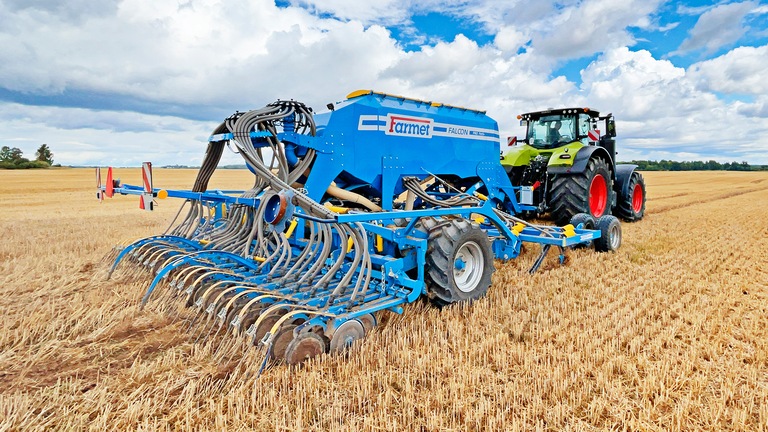The standard method is strip sowing in a shallow cultivated stubble. A shallow stubble cultivation to a depth of 5-8 cm is useful there, where it is necessary to spread plant residues and mechanically eliminate weeds. Important is good dispersal of weeds and straws. On heavy soils, shallow stubble cultivation is also useful because it creates a sufficient proportion of finely crumbled soil on the soil surface to ensure better contact of the small seed roots with the soil moisture. Certain proportion of clods does not matter and is even necessary. The depth of cultivation with the chisel section of the Falcon during sowing is ideally 15-20 cm. Doses of granular fertiliser applied to the soil during sowing can be 50-500 kg/ha. In the case of heavily wet heavy soil, the cultivation depth can be reduced to 10-12 cm. In this case, the use of fertilisers without nitrogen and at lower doses is recommended so that the development of the plant root system is not negatively affected. This is because if the roots experience a higher nitrogen concentration, they will stop growing deeply and begin to branch out sideways. Sowing depth is optimally 2-3 cm. The sowing depth must ensure reliable rooting after germination, which can be initiated not only by rainfall but also by morning dew in rape. Too shallowly sown crops can be risky without heavy rainfall in dry soil. If the soil at the cultivation depth is moist enough, this moist soil is brought to the surface by the chisels and the seed laid in it grows significantly faster and the plants are more vigorous. The crops are better integrated than with conventional sowing. The technology ensures stable yields at the level of conventional processes. Strip sowing in the cultivated soil is suitable not only for rape, but also for cereals and legumes. Narrow rows of 12.5 cm can also be used for cereals.
Strip seeding directly into the stubble is a significantly expanding method. On medium and lighter soils, if there is stubble with well spread plant residues and no weeds, it is much more convenient to carry out strip sowing directly without cultivation. The depth of cultivation with chisels is ideally 15-20 cm. Soil moisture is saved. During sowing, the seed enters the wetter soil brought to the surface by the chisels and after sowing the moisture continues to rise very intensively to the seed. The seed germinates faster and the germination rate is very high. This effect is significantly shown even in severely dry years with significant overall moisture deficit. The optimum sowing depth is again 2-3 cm. Growth sown directly into the stubble are regularly among the most balanced and best integrated. The superior moisture supply from the deeper layers of the soil manifests throughout the growing season and ensures high yields. Correct application of fertiliser is very important, targeting the root zone. The doses of granular fertiliser applied to the soil during sowing can be 50-500 kg/ha. Strip seeding directly into the stubble on sloping land is very beneficial, as it significantly eliminates erosion.
Falcon modular seed drills allow easy side movement of the rear sowing section so that the even seed coulters placing the seed directly into the perforated strips above the placed fertiliser.
